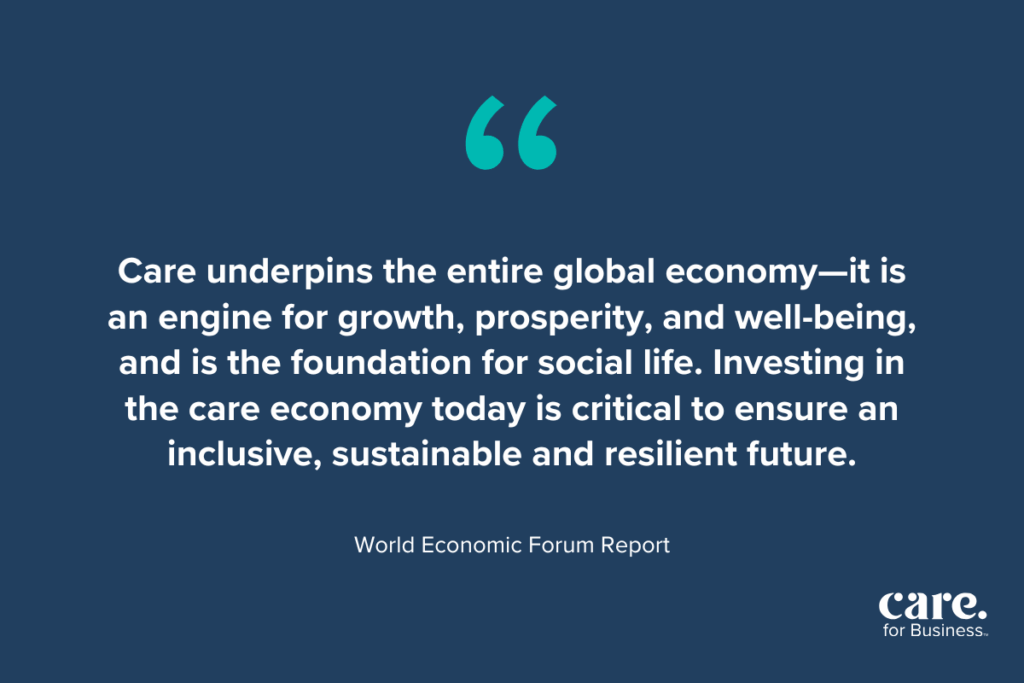About the author: Sherri Snelling is a corporate gerontologist, author, podcast host and CEO of the Caregiving Club. She presents the monthly “Care Talks for Aging and Adult Care” webinars to Care for Business employer clients.
In July 2025, the National Alliance for Caregiving and AARP published their “Caregiving in the U.S.” report. The latest numbers are red flags for employers:
- The U.S. now has 63 million caregivers—10 million more than five years ago and a 45% increase since 2015.
- Seven in ten caregivers are working and represent one in five employees in your workplace.
Most employers define caregiving employees as those caring for children or older parents or grandparents. But it can also mean caring for a spouse, a disabled or neurodiverse child or adult, and other loved ones. And one-third of all caregivers fall into the Sandwich Generation; those caring for children and older parents simultaneously.
This all begs the question: Is your workplace ready?

Senior care by the numbers
While child care has been a focus of HR benefits for the last 50 years, senior care requires as much attention and support, yet has always flown under the radar.
Just recently, we hit a milestone in U.S. history: for the first time, we now have more parents to care for (people over 65 living potentially to 100) than children (infants to age 18).
With 24 million employees caring for an older adult, the senior care part of the caregiving equation cannot be ignored.
And the reality of longevity is that our healthspans are not matching our lifespans. What this means for employers is that more employees will be joining what I call Gen C: Generation Caregiver.
Consider these statistics on healthspans and lifespans
Women age 65 today have a 25% chance of living to age 96
This statistic is underscored by how many boomer women may not have the financial savings to actually live another 35 years. In addition, we know women represent 2/3 of all Alzheimer’s cases and in fact, after age 45 women have a one-in-five chance of developing Alzheimer’s.
While longevity is appealing, the caregiving realities of having more moms that need help financially or who need dementia care is a real consideration.
Boomers may live longer but healthspans and wealthspans are not matching their lifespans
The youngest of the baby boomers, known as Peak 65, represent about 4.1 million Americans who will turn 65 by 2025, with all boomers achieving that milestone by 2027, when the oldest boomers will turn age 80.
Longevity is here, but it also ushers in more caregiving needs: seven in ten people over 65 need some type of help or care with daily living.And, unfortunately, many boomers are not financially resilient. Most adults need $1.8 million for a 30-year retirement yet the average boomer has less than $200,000 saved.
This is why older adults are working longer or will spend more years being cared for (physically, emotionally and financially) by a loved one in a younger generation.
By 2038, U.S. households with someone over 80 will double to more than 10 million
With 20% of those age 50+ needing help with activities of daily living (ADLs) and 60% requiring assistance with mobility problems, caregivers need flexibility at work to support multigenerational households or provide care needs in an older loved one’s home.
Impact on the modern workplace
The physical, emotional, and financial tolls of caregiving can negatively impact the productivity and overall physical and mental health of this employee/caregiver population. A 2019 Harvard study found one-third of employees—more than half in middle or senior management positions—left their jobs to become a full-time caregiver to an older parent or other loved one.
Replacing those employees is costly. A follow-up 2024 Harvard report showed companies that offer caregiving support are likely to see a reduction in turnover by at least 5-6% translating into millions of dollars saved.
In 2025, Care for Business conducted a survey that found approximately one in five employees (19%) have left a job because their employer did not provide family care benefits and 20% would leave one employer for another if they had access to senior care support.
Attention HR leaders: Trends driving caregiver support in the workplace
Harvard found more than half of companies do not track their organization’s caregiving demographics nor conduct a yearly caregiving audit. And a different survey showed less than 12% of employers take an annual assessment of caregiving among employees.
An audit that drives benefit support and innovation for caregivers would be ideal, and yet employees are still concerned about the stigma of their role with supervisors and fellow workers. One survey showed almost half of caregivers said their workplace supervisors are not aware of their caregiving responsibilities outside of work.
Change is coming, though.
In 2025, U.S. News & World Report, SHRM, and the Milken Institute launched the first annual “Best Companies Supporting Family Caregiving” rankings, driving more awareness and ultimately more competition for talent.
A recent Forbes article, “The rise of the chief longevity officer—where demographics meets strategy” outlined how “a new generation of corporate leaders is treating longevity not as a costly headache, but as a huge new market opportunity. They are reframing ageing from stigma to strength. And in doing so, they’re helping organisations stay relevant in an era where the fastest-growing customer and talent segments are over 50.”
From global beauty brand L’Oréal to financial services giant Bank of America, companies are hiring chief longevity officers or chief gerontology officers to lead cross-departmental consulting across product design, customer service, marketing, and human resources—recognizing longevity demographics as being just as vital as AI or environmental sustainability.

Caregivers need corporate wellness
A NAC/AARP survey showed nearly one in four (24%) caregivers provide 40 or more hours of care per week and four in ten caregivers are in high-intensity care roles.
Even more alarming is during the pandemic, surveys showed between 72-80% of caregivers expressed burnout and 52% had negative mental health impact with suicidal ideation.This was echoed by a recent Gallup report that found employees who struggle outside of work have 61% higher burnout and two times the mental health issues.
Recognizing that employees who are caregivers need support is an understatement.
But to really change workplace culture, having C-suite champions and fellow caregivers share their personal caregiving stories is a great first step. Also, training middle management and supervisors on the emotional intelligence needed for caregiving employees, is vital to an empathetic work environment.
For caregivers, social support at work is even more vital. A recent employee survey showed only 2 in 10 workers have a “best friend” at work, and studies have found these workplace friendships increase productivity. Happily, a recent workplace equity trends survey found caregivers are the fastest growing employee resource group. Having an employer help caregivers go from feeling all alone to finding their tribe has tremendous bottom-line benefits.
When it comes to caregiver benefits, the challenge for employers is there is no one-size-fits-all checklist.
Everything from paid leave to backup care services to flex time or work-from-home (WFH) options are helpful. But there is a common denominator. A Rosalynn Carter Institute for Caregiving conducted a pilot program with employers and employees for both office workers and hourly/shift workers.
The one thing all employees said would help them most would be a care concierge or specialist: an expert to help guide them to resources and services specific to their caregiving needs. The second request was for more education from employers on caregiving issues and how to find work-life balance.
How to become a caring company
To recap, transforming from a company that simply offers caregiving benefits to one known for a caregiving-friendly culture requires:
- An annual audit of caregiving employees and their issues
- Ensuring that senior care programs and benefits get as much attention as child care
- Recognition and celebration from the C-suite for its caregiving employees, including encouraging an ERG
- Training for supervisors and managers on how to support employees who are caregivers
- Hiring a chief longevity officer or having gerontology experts as key consultants
- Providing a care concierge or specialist service to help guide and counsel employees to their specific caregiving needs
- Providing education on caregiving topics, including financial costs of care, on a consistent basis
- Connecting caregivers to wellness programs that help them with their work-life balance
Understanding longevity (lifespans) and caregiving (healthspans and wealthspans) are critical guide rails to healthy companies who will improve what is now being called “thrivespans.” Employers play a crucial role in their worker’s lives but also for society and the economy at large.

